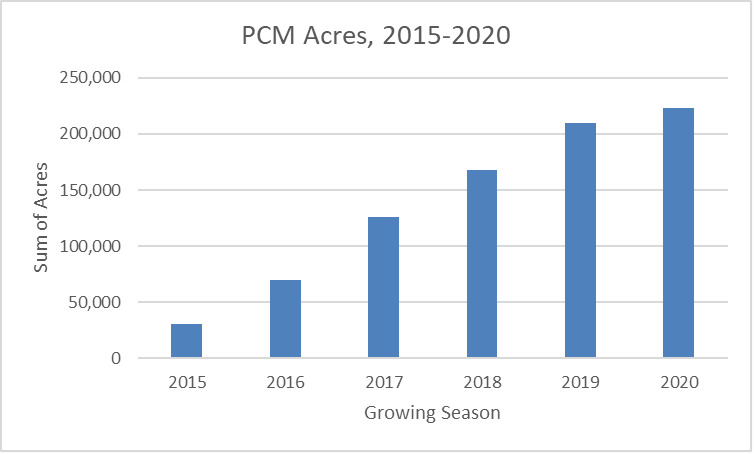The months of January through March are particularly busy for those of us working with the Precision Conservation Management program (PCM). That’s when we are developing and delivering our customized reports to each PCM cooperator across Illinois and Kentucky. We’re always glad to see the end of March come since – right when Illinois farmers are about to spring into action with planting activities – we are more than ready for a little breather.
But we did have a chance to pull together some numbers summarizing the impacts of the PCM program.
Let’s start with program enrolled acres. PCM has grown substantially since the program began in 2016. As shown in the table below, PCM currently has 223,000 acres enrolled in Illinois, representing a seven-fold increase since the program began. Cumulatively, there are nearly 827,000 acres in the PCM dataset.

The program began in 2016 with just 56 farmers enrolled (and just one PCM Specialist – Hi, Clay – in just one PCM region). Today, we have 280 farmers enrolled in PCM in Illinois and they are serviced by four PCM Specialists in four regions. And, with the recent news that the Illinois Soybean Association is joining IL Corn Growers Association as a full partner in PCM, PCM is essentially doubling in size expanding into three new regions in southwest, northwest, and northern Illinois. Be sure to stay tuned for even more growth over the next few years!
Here’s a breakdown of PCM farmers’ management practices:
- 85% use reduced tillage on some part of their farmed acres
- 63% apply the majority of their N applications in-season on some part of their corn acres
- 35% grow an overwintering cover crop on some portion of their farmed acres
Let’s talk conservation acres. In 2020, our PCM dataset reflected:
- over 141,000 acres of reduced tillage
- almost 62,000 acres of in-season N fertilizer application for corn
- more than 25,000 acres of cover crops.
Finally, how about impacts on water quality and soil loss? In 2020 alone, PCM farmers achieved the following nutrient and sediment loss reductions:
- Over 615,000 lb NO3-N loss reductions
- Over 90,000 lb P loss reductions
- Over 127,000 tons of sediment loss reductions
We know that these numbers alone won’t stop new agricultural regulations or satisfy the goals of the Illinois Nutrient Loss Reduction Strategy, but these numbers are only a small part of the full impact that PCM is having on Illinois agriculture. The full measure of PCM’s value can be demonstrated with the influence of our reporting on farmers across Illinois and beyond – reporting that is based on solid and objective analysis of real-world, local data. It is PCM’s reporting that gives farmers the confidence to make decisions that impact both their family’s financial situation and our environment. PCM knows winning is not enough. We’re here for the win-win: increasing farm incomes AND improving environmental outcomes.
For more information about PCM, please visit our website precisionconservation.org.




 and then
and then